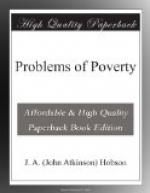We see then the multitudinous units of capital and labour crystallizing ever into larger and larger masses, moving towards an ideal goal which would present a single body of organized capital and a single body of organized labour. The process in each case is stimulated by the similar process in the other. Each step in the organization of labour forces a corresponding move towards organization of capital, and vice versa. Striking examples of this imitative strategic movement have been presented by the rapid temporary organization of Australian capital, and by the effect of Dock Labourers’ Unions in England in promoting the closer co-operation of the capital of shipowners. By this interaction of the two forces, the development in the organization of capital and labour presents itself as a pari passu progress; or perhaps more strictly it goes by the analogy of a game of draughts; the normal state is a series of alternate moves; but when one side has gained a victory, that is, taken a piece, it can make another move.
Sec. 8. Relation of Low-skilled Labour to the wider Movement.—The relation in which this large industrial evolution stands to our problem of the poor low-skilled worker is not obscure. In comparing the movement of capital with that of labour we saw that in one respect the former was clearer and more perfect. The weaker capitalist, he who fails to keep pace with industrial progress, and will not avail himself of the advantage which union gives to contending pieces of capital, is simply snuffed out; that is, he ceases to have an independent existence as a capitalist when he can no longer make profit. The laggard, ill-managed piece of capital is swept off the board. This is possible, for the capital is a property separable from its owner. The case of labour is different. The labour-power is not separable from the person of the labourer. So the labourer left behind in the evolution of labour organization does not at once perish, but continues to struggle on in a position which is ever becoming weaker. “Organize or starve,” is the law of modern labour movements. The mass of low-skilled workers find themselves fighting the industrial battle




